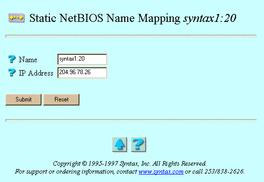6.3 Administering Static NetBIOS Name Mappings
UDP broadcast datagrams normally resolve NetBIOS names owned by remote servers and workstations. You can augment this dynamic resolution by defining static NetBIOS name-to-IP address mappings.
A static NetBIOS name mapping consists of a NetBIOS name from one to 15 characters, a name type from 0 to 255, and a corresponding IP address. TAS resolves a NetBIOS name by first searching the list of static NetBIOS names and, failing that, broadcasting a query for the desired name. You can augment name resolution to effectively cross routers by using the Enterprise Name Service (see "6.1 Modifying TCP/IP Configuration") or Windows Internet Naming Service.
Follow these steps to create, modify, or delete static NetBIOS names:
-
Follow these links:
Transports->Static NetBIOS Name mappings
The Static NetBIOS Name mappings screen appears.
-
From the list, select the NetBIOS name you want to modify or delete, or enter the name you want to create in the text field. If deleting, you may select more than one name. You must use a valid service name and follow it with a type code, usually :20. The list contains nothing if no NetBIOS name mappings exist.
-
Click Create, Modify, or Delete. The Modify and Delete buttons do not appear if no static NetBIOS name mappings exist.
If you clicked Create or Modify, the Static NetBIOS Name Mapping servicename screen below appears. Go to Step 4.
If you clicked Delete, the Confirmation screen appears. Click OK. The Static NetBIOS Names screen appears. Click OK. Do not go to Step 4.

-
Enter values for the following attributes:
-
Name -- The NetBIOS name. If you clicked Modify, this attribute does not appear.
-
IP Address -- The IP address to which Name should map.
-
-
Click Submit.
The Static NetBIOS Name Mapping servicename screen appears.
-
Click OK.
To administer static NetBIOS name mappings from the UNIX command line, use the tnsname command.
- © 2010, Oracle Corporation and/or its affiliates
